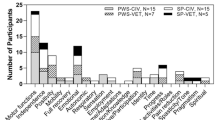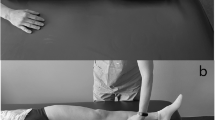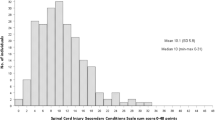Abstract
Study design
Psychometric study.
Objectives
Evaluate the intra-rater and inter-rater reliability of the Penn Spasm Frequency Scale (PSFS) in people with chronic traumatic spinal cord injury (SCI).
Setting
Community setting.
Methods
Participants with chronic traumatic SCI were administered the PSFS, a self-reported spasticity measure in which the individual documents the frequency (Part 1) and severity (Part 2) of their muscle spasms. One rater administered the PSFS at baseline, 5 to 10 days, and 4 to 6 weeks after baseline. The second rater administered the PSFS within 3 days of the first rater.
Results
Reliability was assessed using weighted-kappa (95% confidence interval) statistics. In 61 participants, the intra-rater reliability between 5 to 10 days and 4 to 6 weeks after baseline was 0.822 (0.709, 0.935) and 0.734 (0.586, 0.883), respectively, for PSFS Part 1. With the addition of Part 2, the intra-rater reliabilities were 0.812 (0.705, 0.919) and 0.729 (0.586, 0.872) for 5 to 10 days and 4 to 6 weeks, respectively. The PSFS inter-rater reliability within a 3-day time interval was 0.862 (0.759, 0.965) for Part 1 and 0.857 (0.762, 0.952) with the addition of Part 2.
Conclusions
PSFS Part 1 intra-rater and inter-rater reliability weighted-kappa statistics are in the “almost perfect” category, with lower confidence bounds in the “substantial” range. By adding Part 2 the reliability decreases, but the kappa statistics remain “substantial,” with a lower confidence bound in the “moderate” range. The PSFS is probably a reliable outcome measure to assess self-reported spasticity after chronic traumatic SCI.
Similar content being viewed by others
Log in or create a free account to read this content
Gain free access to this article, as well as selected content from this journal and more on nature.com
or
References
Pandyan A, Gregoric M, Barnes M, Wood D, Van Wijck F, Burridge J. et al. Spasticity: clinical perceptions, neurological realities and meaningful measurement. Disabil Rehabil. 2005;27:2–6. https://doi.org/10.1080/09638280400014576.
Holtz KA, Lipson R, Noonan VK, Kwon BK, Mills PB. Prevalence and effect of problematic spasticity following traumatic spinal cord injury. Arch Phys Med Rehabil. 2016. https://doi.org/10.1016/j.apmr.2016.09.124.
Phadke CP, Balasubramanian CK, Ismail F, Boulias C. Revisiting physiologic and psychologic triggers that increase spasticity. Am J Phys Med Rehabil. 2013;92:357–69. http://www.ncbi.nlm.nih.gov/pubmed/23620900. Accessed 22 July 2014.
Lechner H, Frotzler A, Eser P. Relationship between self- and clinically rated spasticity in spinal cord injury. Arch Phys Med Rehabil. 2006;87:15–9. https://doi.org/10.1016/j.apmr.2005.07.312.
Priebe MM, Sherwood AM, Thornby JI, Kharas NF, Markowski J. Clinical assessment of spasticity in spinal cord injury: a multidimensional problem. Arch Phys Med Rehabil. 1996;77:713–6. http://www.ncbi.nlm.nih.gov/pubmed/8670001. Accessed 22 July 2014.
Adams MM, Ginis KAM, Hicks AL. The spinal cord injury spasticity evaluation tool: development and evaluation. Arch Phys Med Rehabil. 2007;88:1185–92. https://doi.org/10.1016/j.apmr.2007.06.012.
Hsieh JTC, Wolfe DL, Miller WC, Curt A. Spasticity outcome measures in spinal cord injury: psychometric properties and clinical utility. Spinal Cord. 2008;46:86–95. https://doi.org/10.1038/sj.sc.3102125.
Kita M, Goodkin DE. Drugs used to treat spasticity. Drugs. 2000;59:487–95.
Hamjian JA, Walker FO. Serial neurophysiological studies of intramuscular botulinum-A toxin in humans. Muscle Nerve. 1994;17:1385–92. https://doi.org/10.1016/j.apmr.2007.06.012.
Kirshblum SC, Waring W, Biering-Sorensen F, Burns SP, Johansen M, Schmidt-Read M. et al. Reference for the 2011 revision of the International Standards for Neurological Classification of Spinal Cord Injury. J Spinal Cord Med. 2011;34:547–54. https://doi.org/10.1179/107902611X13186000420242.
Biering-Sørensen F, DeVivo MJ, Charlifue S, Chen Y, New PW, Noonan V. et al. International Spinal Cord Injury Core Data Set (version 2.0)—including standardization of reporting. Spinal Cord. 2017;55:759–64. https://doi.org/10.1038/sc.2017.59.
Guillaume D, Van Havenbergh A, Vloeberghs M, Vidal J, Roeste G. A clinical study of intrathecal baclofen using a programmable pump for intractable spasticity. Arch Phys Med Rehabil. 2005;86:2165–71. https://doi.org/10.1016/j.apmr.2005.05.018.
Hornby TG, Rymer WZ, Benz EN, Schmit BD. Windup of flexion reflexes in chronic human spinal cord injury: a marker for neuronal plateau potentials?. J Neurophysiol. 2003;89:416–26. https://doi.org/10.1152/jn.00979.2001.
Viera AJ, Garrett JM. Understanding interobserver agreement: the kappa statistic. Fam Med. 2005;37:360–3. http://www.ncbi.nlm.nih.gov/pubmed/15883903. Accessed 8 Sept 2017
Acknowledgements
We thank the following individuals for their contributions: Farhana Dossa, MSc, Carlen K Fung, RN, and Alvin Ip, MD, for assistance with participant recruitment and data collection; Allan Aludino of the Vancouver Spine Research Program for database management and data abstraction; Eric C Sayre, PhD, for statistical analysis.
Funding
Dr. Kwon is the Canada Research Chair in Spinal Cord Injury and received financial support from the VGH & UBC Hospital Foundation during conduction of this research.
Author information
Authors and Affiliations
Corresponding author
Ethics declarations
Conflict of interest
The authors declare that they have no conflict of interest.
Rights and permissions
About this article
Cite this article
Mills, P.B., Vakil, A.P., Phillips, C. et al. Intra-rater and inter-rater reliability of the Penn Spasm Frequency Scale in People with chronic traumatic spinal cord injury. Spinal Cord 56, 569–574 (2018). https://doi.org/10.1038/s41393-018-0063-5
Received:
Revised:
Accepted:
Published:
Issue date:
DOI: https://doi.org/10.1038/s41393-018-0063-5
This article is cited by
-
The effects of nabiximols (Sativex®) on spasticity and non-motor symptoms in chronic spinal cord injury (SCI): a longitudinal prospective study
Spinal Cord Series and Cases (2025)
-
Transcutaneous spinal cord stimulation combined with robotic-assisted body weight-supported treadmill training enhances motor score and gait recovery in incomplete spinal cord injury: a double-blind randomized controlled clinical trial
Journal of NeuroEngineering and Rehabilitation (2025)
-
Relationship between reticulospinal system sensitization and proprioceptive pathways in the development of dynamic spasticity (ReProDS) post-spinal cord injury: protocol for a prospective, observational cohort study
BMC Neurology (2024)
-
Muscle Excitability Scale for the assessment of spastic reflexes in spinal cord injury: development and evaluation
Spinal Cord (2024)
-
Non-invasive spinal cord electrical stimulation for arm and hand function in chronic tetraplegia: a safety and efficacy trial
Nature Medicine (2024)



